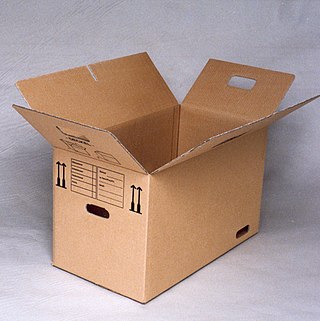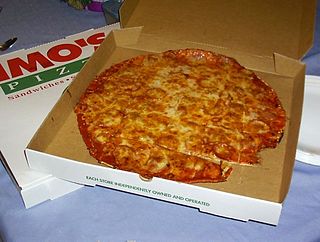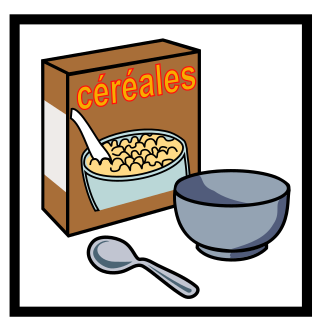
Corrugated fiberboard or corrugated cardboard is a type of packaging material consisting of a fluted corrugated sheet and one or two flat linerboards. It is made on "flute lamination machines" or "corrugators" and is used for making corrugated boxes. The corrugated medium sheet and the linerboard(s) are made of kraft containerboard, a paperboard material usually over 0.25 millimetres (0.01 in) thick.

A box is a container used for the storage or transportation of its contents. Most boxes have flat, parallel, rectangular sides. Boxes can be very small or very large and can be used for a variety of purposes, from functional to decorative.

Paperboard is a thick paper-based material. While there is no rigid differentiation between paper and paperboard, paperboard is generally thicker than paper and has certain superior attributes such as foldability and rigidity. According to ISO standards, paperboard is a paper with a grammage above 250 g/m2, but there are exceptions. Paperboard can be single- or multi-ply.

Packaging is the science, art and technology of enclosing or protecting products for distribution, storage, sale, and use. Packaging also refers to the process of designing, evaluating, and producing packages. Packaging can be described as a coordinated system of preparing goods for transport, warehousing, logistics, sale, and end use. Packaging contains, protects, preserves, transports, informs, and sells. In many countries it is fully integrated into government, business, institutional, industrial, and for personal use.

A carton is a box or container usually made of liquid packaging board, paperboard and sometimes of corrugated fiberboard. Many types of cartons are used in packaging. Sometimes a carton is also called a box.

A paper bag is a bag made of paper, usually kraft paper. Paper bags can be made either with virgin or recycled fibres to meet customers' demands. Paper bags are commonly used as shopping carrier bags and for packaging of some consumer goods. They carry a wide range of products from groceries, glass bottles, clothing, books, toiletries, electronics and various other goods and can also function as means of transport in day-to-day activities.

Hot-melt adhesive (HMA), also known as hot glue, is a form of thermoplastic adhesive that is commonly sold as solid cylindrical sticks of various diameters designed to be applied using a hot glue gun. The gun uses a continuous-duty heating element to melt the plastic glue, which the user pushes through the gun either with a mechanical trigger mechanism on the gun, or with direct finger pressure. The glue squeezed out of the heated nozzle is initially hot enough to burn and even blister skin. The glue is sticky when hot, and solidifies in a few seconds to one minute. Hot-melt adhesives can also be applied by dipping or spraying, and are popular with hobbyists and crafters both for affixing and as an inexpensive alternative to resin casting.
A contract packager, or co-packer, is a company that packages products for their clients. The packaging and labeling services can be used for many types of products including foods, pharmaceuticals, household products, and industrial products.

The folding carton created the packaging industry as it is known today, beginning in the late 19th century. The process involves folding carton made of paperboard that is printed, laminated, cut, then folded and glued. The cartons are shipped flat to a packager, which has its own machinery to fold the carton into its final shape as a container for a product. An example of such a carton is a cereal box.

A tube, squeeze tube, or collapsible tube is a collapsible package which can be used for viscous liquids such as toothpaste, artist's paint, adhesive, caulk, & ointments. Basically, a tube is a cylindrical, hollow piece with a round or oval profile, made of plastic, paperboard, aluminum, or other metal. In general, on one end of the tube body there is a round orifice, which can be closed by different caps and closures. The orifice can be shaped in many different ways: plastic nozzles in various styles and lengths are most typical. The other end is sealed either by welding or by folding.

A conveyor system is a common piece of mechanical handling equipment that moves materials from one location to another. Conveyors are especially useful in applications involving the transport of heavy or bulky materials. Conveyor systems allow quick and efficient transport for a wide variety of materials, which make them very popular in the material handling and packaging industries. They also have popular consumer applications, as they are often found in supermarkets and airports, constituting the final leg of item/ bag delivery to customers. Many kinds of conveying systems are available and are used according to the various needs of different industries. There are chain conveyors as well. Chain conveyors consist of enclosed tracks, I-Beam, towline, power & free, and hand pushed trolleys.

A vertical form fill sealing machine is a type of automated assembly-line product packaging system, commonly used in the packaging industry for food and many other products. Walter Zwoyer, the inventor of the technology, patented his idea for the VFFS machine in 1936 while working with the Henry Heide Candy Company. The machine constructs plastic bags and stand-up pouches out of a flat roll of film, fills them with product, and seals them. Both solids and liquids can be bagged.

Corrugated box design is the process of matching design factors for corrugated fiberboard or corrugated plastic boxes with the functional physical, processing and end-use requirements. Packaging engineers work to meet the performance requirements of a box while controlling total costs throughout the system. Corrugated boxes are shipping containers used for transport packaging and have important functional and economic considerations.
Pro Mach, Inc. is a packaging machinery company headquartered in Covington, Kentucky. It was founded in 1998 and is a member of The Association for Packaging and Processing Technologies (PMMI).

Packaging machinery is used throughout all packaging operations, involving primary packages to distribution packs. This includes many packaging processes: fabrication, cleaning, filling, sealing, combining, labeling, overwrapping, palletizing.

Luxury and specialty packaging is the design, research, development, and manufacturing of packaging, displays, and for luxury brands. The packaging of a luxury product is part of the brand’s image and research shows consumers are willing to spend more on products if the packaging looks appealing and luxurious.

A case sealer or box sealer is a piece of equipment used for closing or sealing corrugated boxes. It is most commonly used for regular slotted containers (RSC) and can involve adhesive, box sealing tape, or Gummed tape.

A security bag is a heavy duty bag used to contain high-value products or documents or legally sensitive items. Envelopes with security features are called security envelopes as well as security bags. Cash for deposit in a bank is often placed in a special deposit bag with security features. When used to contain items related to a crime, special evidence bags are used. Authentication of signatures and chain of custody are often required.

The pizza box or pizza package is a folding packaging box usually made of corrugated fiberboard in which hot pizzas are stored for take-out. The pizza box also makes home delivery and takeaway substantially easier. The pizza box has to be highly resistant, cheap, stackable, thermally insulated to regulate humidity and suitable for food transportation. In addition, it provides space for advertising. The pizza packages differ from those of frozen pizzas, which contain the frozen product in heat-sealed plastic foils as is the case with much frozen food.

Overpackaging is the use of excess packaging. The Institute of Packaging Professionals defines overpackaging as “a condition where the methods and materials used to package an item exceed the requirements for adequate containment, protection, transport, and sale”


















